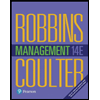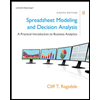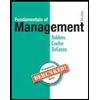
The ADKAR model of change focuses on the "people" side of change (i.e., how people move through and experience change). The five elements of ADKAR—Awareness, Desire, Knowledge, Ability, and Reinforcement—reflect the outcomes needed for individual change to succeed.
Consider your current organization or an organization with which you were once affiliated, and address the following:
Provide an example of a change initiative of a collegue getting promoted you experienced.
Discuss how each of the five elements of ADKAR was applied or could have been applied to support the success of the change initiative.
Which element of the ADKAR model do you believe was the most challenging for you to embrace? Why?
Trending nowThis is a popular solution!
Step by stepSolved in 2 steps

- Explain the refreezing stage in Lewin’s field force model of change.arrow_forwardConsider your personal schema for handling and managing change. Do you work with a one-size-fits-all approach to change management? To what extent do you adapt your approach to the scale and timing of the change? To your own relative power in the situation? To other context features as identified and related to change management, processual, and contingency approaches?arrow_forward1. How is “empower action” a specific change management technique or tool you think is most likely to pave the way for a successful launch of the new product line? 2. How is “incremental change” the most likely decision-making oversight the board could make in the launch of a new product line?arrow_forward
- discuss each of the Organizational Change Skills as they apply to your organization (Tesla Inc.) Where are these skills “housed” in terms of the key individuals and groups identified: Delivery team Vendors Influential leaders Impacted peoplearrow_forwardMiddle managers need to be involved in the change process, even if they are not the change agents or champions Question 20Select one: True Falsearrow_forwardIn class, we talked about the surprising outcome of the malaria prevention that free mosquito net provided to local community members were used for fishing. Which one of the following attributes of innovation in the diffusion of innovation theory helped explain this outcome? Group of answer choices demonstrability complexity perceived relative advantage compatibilityarrow_forward
- Company ABC is currently experiencing a lack of cooperation between employees and a general distrust and fear of abandoning business processes that worked well in the past. Applying Lewin’s ‘Unfreeze-Change-Re-freeze’ change theory, provide a step-by-step strategy of how the company may overcome these common barriers to implementing change.arrow_forwardChange management is essential in communicating change in a organization. In looking at the American heart association as a healthcare organization, what is a change management model or theory you would recommend this organization used regarding changes it makes? Why?arrow_forwardThe responsibilities for managing change are often distributed across an organization. Therefore, assessing the knowledge, skills, and abilities (KSAs) of those tasked with driving change forward is imperative. The Change Management Institute identified 12 competencies for effective change managers to demonstrate. Why should organizations assess the competencies of individuals responsible for driving change initiatives? Explain. What KSAs do you possess related to the 12 competencies? Why are these important? Are there any change management competencies identified by the Change Management Institute that you currently do not possess but believe would be valuable to develop? Explain.arrow_forward
- Change management involves the process of planning, implementing, and controlling changes within an organization to achieve desired outcomes while minimizing resistance and disruptions. This can include changes in processes, technology, organizational structure, culture, or strategies. Effective change management requires clear communication, stakeholder engagement, and strategic planning to ensure that employees understand the reasons for change and are adequately prepared to adapt. It also involves identifying and addressing potential barriers to change, such as resistance from employees, lack of buy-in from leadership, or insufficient resources. By employing change management methodologies and tools, such as stakeholder analysis, communication plans, and training programs, organizations can increase the likelihood of successful change implementation and mitigate potential negative impacts on productivity and morale Question: How can managers effectively communicate and engage with…arrow_forwardChange management is the process of planning, implementing, and monitoring changes in an organization to ensure successful outcomes and minimize resistance. Change can take various forms, including organizational restructuring, technology implementation, process improvements, or shifts in company culture. Effective change management involves several key principles. Firstly, it's essential to create a compelling vision for the change, clearly articulating the reasons behind it and the benefits it will bring. Communicating this vision to all stakeholders helps to build understanding and buy-in. In addition, involving employees in the change process by seeking their input, addressing concerns, and providing opportunities for training and development fosters a sense of ownership and reduces resistance. Furthermore, establishing clear goals, timelines, and performance metrics helps to track progress and ensure accountability throughout the change initiative. Flexibility and adaptability are…arrow_forwardThis week focuses on change and positive reinforcement. What are some incentives that can be implemented to promote change? What incentives would work well for you? Why? Explain and provide rationale to support your response.arrow_forward
 Understanding BusinessManagementISBN:9781259929434Author:William NickelsPublisher:McGraw-Hill Education
Understanding BusinessManagementISBN:9781259929434Author:William NickelsPublisher:McGraw-Hill Education Management (14th Edition)ManagementISBN:9780134527604Author:Stephen P. Robbins, Mary A. CoulterPublisher:PEARSON
Management (14th Edition)ManagementISBN:9780134527604Author:Stephen P. Robbins, Mary A. CoulterPublisher:PEARSON Spreadsheet Modeling & Decision Analysis: A Pract...ManagementISBN:9781305947412Author:Cliff RagsdalePublisher:Cengage Learning
Spreadsheet Modeling & Decision Analysis: A Pract...ManagementISBN:9781305947412Author:Cliff RagsdalePublisher:Cengage Learning Management Information Systems: Managing The Digi...ManagementISBN:9780135191798Author:Kenneth C. Laudon, Jane P. LaudonPublisher:PEARSON
Management Information Systems: Managing The Digi...ManagementISBN:9780135191798Author:Kenneth C. Laudon, Jane P. LaudonPublisher:PEARSON Business Essentials (12th Edition) (What's New in...ManagementISBN:9780134728391Author:Ronald J. Ebert, Ricky W. GriffinPublisher:PEARSON
Business Essentials (12th Edition) (What's New in...ManagementISBN:9780134728391Author:Ronald J. Ebert, Ricky W. GriffinPublisher:PEARSON Fundamentals of Management (10th Edition)ManagementISBN:9780134237473Author:Stephen P. Robbins, Mary A. Coulter, David A. De CenzoPublisher:PEARSON
Fundamentals of Management (10th Edition)ManagementISBN:9780134237473Author:Stephen P. Robbins, Mary A. Coulter, David A. De CenzoPublisher:PEARSON





